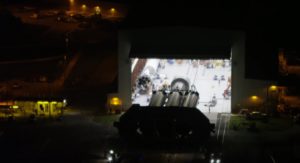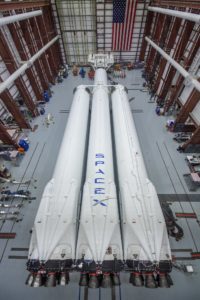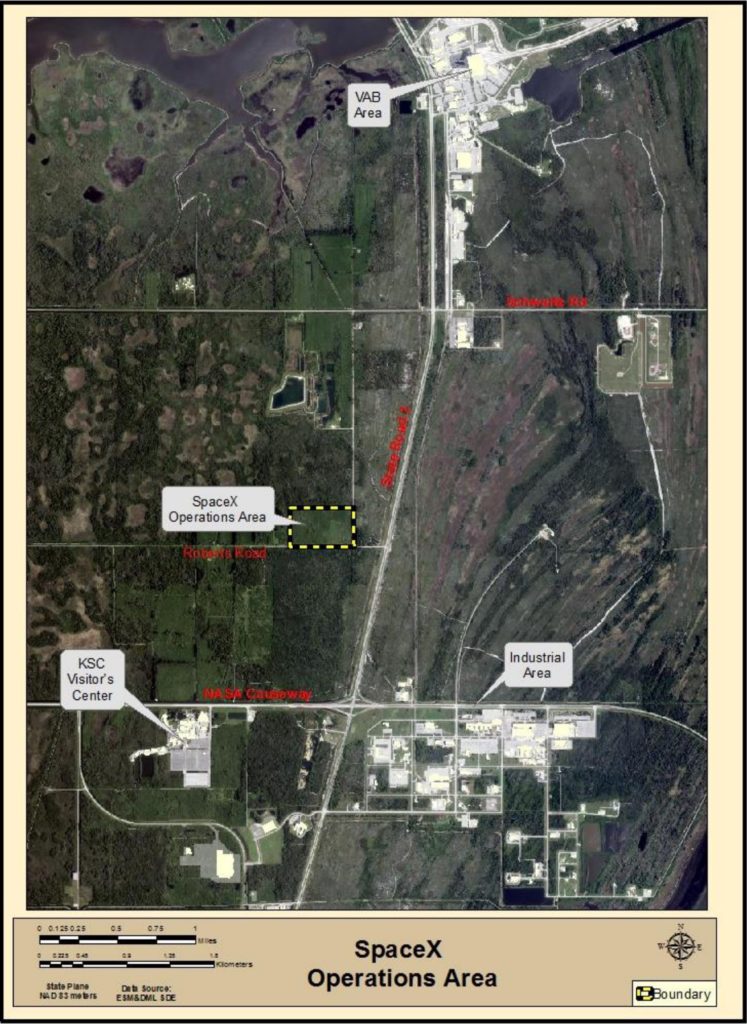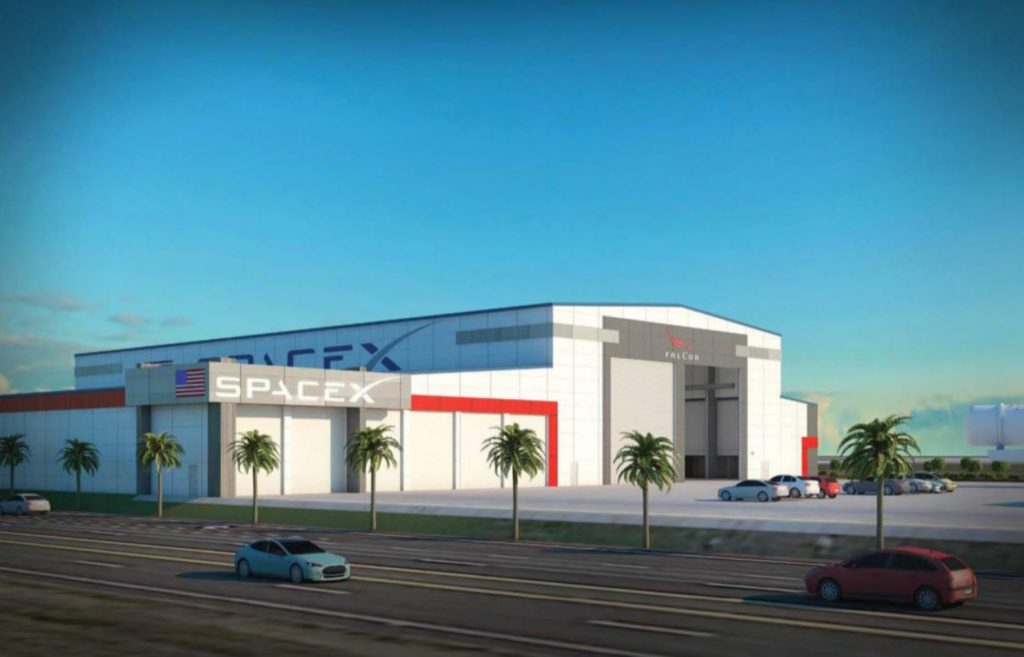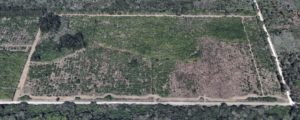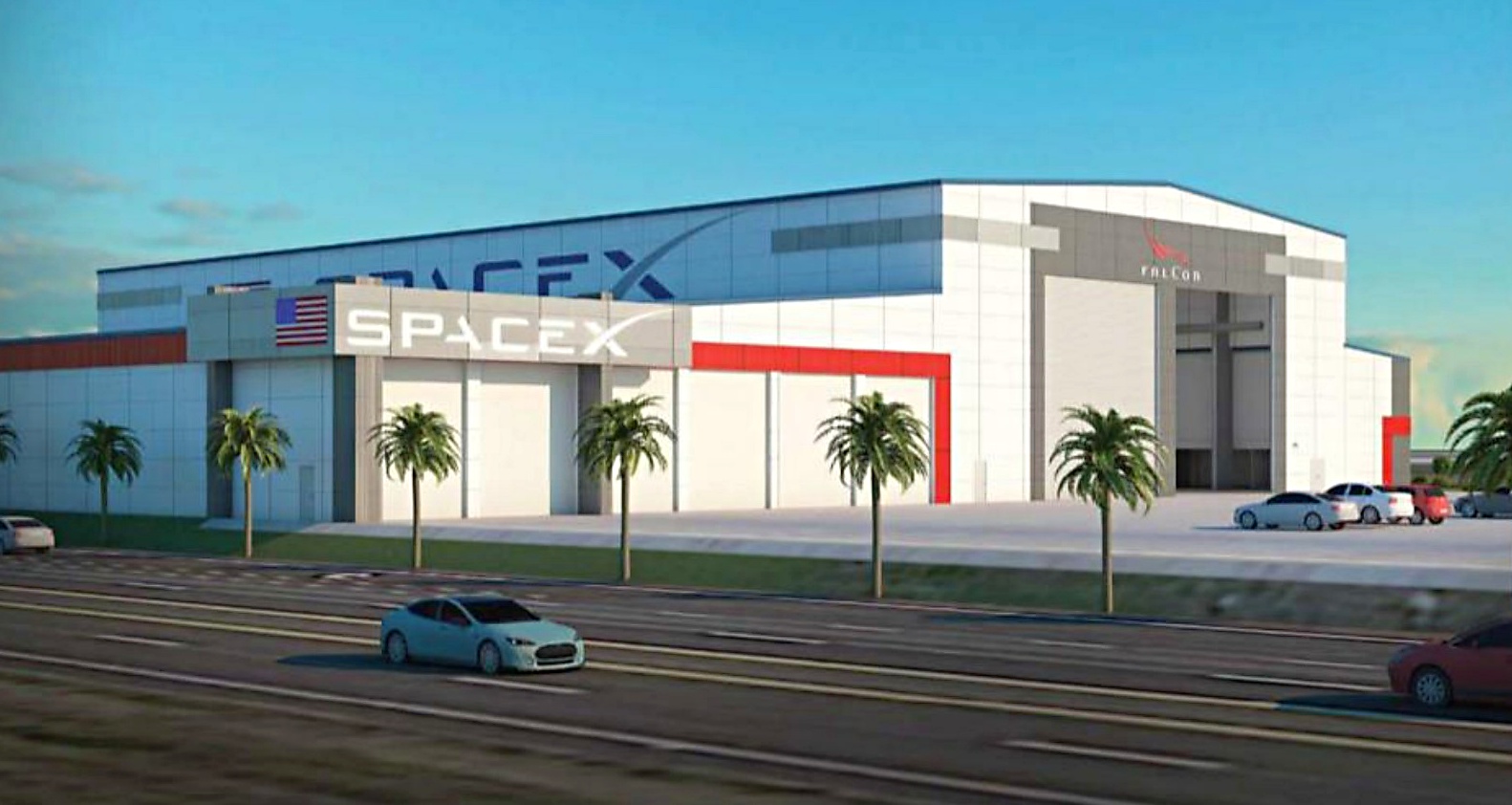

News
SpaceX plans huge expansion for Floridan Falcon refurbishment facilities
According to an environmental assessment published in April 2018, SpaceX aims to build a dedicated facility for storing, refurbishing and decommissioning Falcon 9 and Falcon Heavy boosters and payload fairings “immediately” after construction approvals are granted.
New Falcon 9 and Heavy refurbishment/storage center will be built in Florida
This facility would give SpaceX some 50 acres of land and 130,000 square feet (12,300 m^2) of floor space for the sole purpose of refurbishing and storing flight-proven Falcon 9 and Heavy boosters, as well as the rockets’ payload fairings after successful recoveries begin. If additional storage space proved necessary (and it probably will), another 100,000 ft^2 (9300 m^2) building would be constructed.
- Falcon Heavy rolls out from SpaceX’s largest current booster storage and preparation facility, LC-39A. (SpaceX)
- The first-ever Falcon Heavy (sans payload and fairing) shown inside Pad 39A’s horizontal integration facility (HIF). (SpaceX)
As of today, SpaceX likely has room to store 6-8 Falcon boosters at or near their Florida launch pads, with the bulk of that storage coming from the company’s 50,000 ft^2 (4500 m^2) LC-39A horizontal integration facility (HIF), capable of housing four rocket boosters. As such, an additional 150,000+ ft^2 could nearly quadruple SpaceX’s booster storage and refurbishment capabilities, all while locating that expansion on a single, easily-accessible lot within close reach of both LC-40 and LC-39A launch pads.
Put more simply, the addition of this new Kennedy Space Center facility would hugely benefit SpaceX’s ability to launch, land, and re-launch its reusable rockets as rapidly as possible, and would enable the simultaneous storage and refurbishment of as many as 16-20 Falcon 9/Heavy boosters and at least a dozen payload fairing halves. If even more capacity is required, nearly half of lot SpaceX wants to lease would be untouched and give the company another 30 acres of land to expand into as launch cadence ramps or BFR prepares for its first launches from Florida.
- An overview of SpaceX’s prospective KSC facility and nearby landmarks. (SpaceX)
- A SpaceX render of what the complex might look like once completed. (SpaceX)
- As described in the environmental assessment, more than half of the lot would be free for future expansion. (SpaceX)
60+ annual launches, rocket ‘gardens’, and a wacky control tower
According to comments in the April 2018 assessment, the readiness of these new storage and refurbishment facilities could potentially pave the way for – as early as 2020 – more than 60 annual Falcon 9 and Heavy launches from the company’s two Florida launch pads a number which doesn’t even include SpaceX’s California launch site, nor its prospective Texas launch facilities. In order to support ambitious Florida-specific launch rates, SpaceX also intends to construct a 300-foot tall Launch and Landing Control Center (LLCC) pulled straight from a Bond villain’s lair on the new property.
The [LLCC] is envisioned to be world-class, architecturally distinctive, and equipped for satellite, cargo, and crew missions.
- SpaceX’s proposed Launch and Landing Control Center (LLCC). The Bond villain is strong with this one… (SpaceX)
- Satellite imagery from Google Maps shows the currently-abandoned site of SpaceX’s prospective Florida expansion. (Google Maps)
Distinctive is certainly a good way to describe the proposed control center. Not to be outdone, SpaceX also included plans for its own private rocket garden, essentially an elegant graveyard for decommissioned or uniquely historic Falcon 9 and Heavy rocket boosters and fairings, as well as Dragon spacecraft. Perhaps there will be room for pathfinder Mars rockets and spaceships in the future… With any luck, both the control center and proposed rocket garden are intended to be at least partially open to the public, something that would undoubtedly be a huge hit while also awkwardly competing with Kennedy Space Center’s Visitor Center, which features its own rocket garden less than a mile away.
Although BFR and Mars were never mentioned specifically, something SpaceX appears to have been quite stringent about over the last several months, the environmental assessment also briefly mentioned future uses for the same facility that might include “new launch vehicle” developments, perhaps requiring a four-lane expansion of the adjacent Robert’s Road somewhere down the line.
Follow us for live updates, peeks behind the scenes, and photos from Teslarati’s East and West Coast photographers.
Teslarati – Instagram – Twitter
Tom Cross – Twitter
Pauline Acalin – Twitter
Eric Ralph – Twitter

Elon Musk
Starlink passes 9 million active customers just weeks after hitting 8 million
The milestone highlights the accelerating growth of Starlink, which has now been adding over 20,000 new users per day.

SpaceX’s Starlink satellite internet service has continued its rapid global expansion, surpassing 9 million active customers just weeks after crossing the 8 million mark.
The milestone highlights the accelerating growth of Starlink, which has now been adding over 20,000 new users per day.
9 million customers
In a post on X, SpaceX stated that Starlink now serves over 9 million active users across 155 countries, territories, and markets. The company reached 8 million customers in early November, meaning it added roughly 1 million subscribers in under seven weeks, or about 21,275 new users on average per day.
“Starlink is connecting more than 9M active customers with high-speed internet across 155 countries, territories, and many other markets,” Starlink wrote in a post on its official X account. SpaceX President Gwynne Shotwell also celebrated the milestone on X. “A huge thank you to all of our customers and congrats to the Starlink team for such an incredible product,” she wrote.
That growth rate reflects both rising demand for broadband in underserved regions and Starlink’s expanding satellite constellation, which now includes more than 9,000 low-Earth-orbit satellites designed to deliver high-speed, low-latency internet worldwide.
Starlink’s momentum
Starlink’s momentum has been building up. SpaceX reported 4.6 million Starlink customers in December 2024, followed by 7 million by August 2025, and 8 million customers in November. Independent data also suggests Starlink usage is rising sharply, with Cloudflare reporting that global web traffic from Starlink users more than doubled in 2025, as noted in an Insider report.
Starlink’s momentum is increasingly tied to SpaceX’s broader financial outlook. Elon Musk has said the satellite network is “by far” the company’s largest revenue driver, and reports suggest SpaceX may be positioning itself for an initial public offering as soon as next year, with valuations estimated as high as $1.5 trillion. Musk has also suggested in the past that Starlink could have its own IPO in the future.
News
NVIDIA Director of Robotics: Tesla FSD v14 is the first AI to pass the “Physical Turing Test”
After testing FSD v14, Fan stated that his experience with FSD felt magical at first, but it soon started to feel like a routine.

NVIDIA Director of Robotics Jim Fan has praised Tesla’s Full Self-Driving (Supervised) v14 as the first AI to pass what he described as a “Physical Turing Test.”
After testing FSD v14, Fan stated that his experience with FSD felt magical at first, but it soon started to feel like a routine. And just like smartphones today, removing it now would “actively hurt.”
Jim Fan’s hands-on FSD v14 impressions
Fan, a leading researcher in embodied AI who is currently solving Physical AI at NVIDIA and spearheading the company’s Project GR00T initiative, noted that he actually was late to the Tesla game. He was, however, one of the first to try out FSD v14.
“I was very late to own a Tesla but among the earliest to try out FSD v14. It’s perhaps the first time I experience an AI that passes the Physical Turing Test: after a long day at work, you press a button, lay back, and couldn’t tell if a neural net or a human drove you home,” Fan wrote in a post on X.
Fan added: “Despite knowing exactly how robot learning works, I still find it magical watching the steering wheel turn by itself. First it feels surreal, next it becomes routine. Then, like the smartphone, taking it away actively hurts. This is how humanity gets rewired and glued to god-like technologies.”
The Physical Turing Test
The original Turing Test was conceived by Alan Turing in 1950, and it was aimed at determining if a machine could exhibit behavior that is equivalent to or indistinguishable from a human. By focusing on text-based conversations, the original Turing Test set a high bar for natural language processing and machine learning.
This test has been passed by today’s large language models. However, the capability to converse in a humanlike manner is a completely different challenge from performing real-world problem-solving or physical interactions. Thus, Fan introduced the Physical Turing Test, which challenges AI systems to demonstrate intelligence through physical actions.
Based on Fan’s comments, Tesla has demonstrated these intelligent physical actions with FSD v14. Elon Musk agreed with the NVIDIA executive, stating in a post on X that with FSD v14, “you can sense the sentience maturing.” Musk also praised Tesla AI, calling it the best “real-world AI” today.
News
Tesla AI team burns the Christmas midnight oil by releasing FSD v14.2.2.1
The update was released just a day after FSD v14.2.2 started rolling out to customers.

Tesla is burning the midnight oil this Christmas, with the Tesla AI team quietly rolling out Full Self-Driving (Supervised) v14.2.2.1 just a day after FSD v14.2.2 started rolling out to customers.
Tesla owner shares insights on FSD v14.2.2.1
Longtime Tesla owner and FSD tester @BLKMDL3 shared some insights following several drives with FSD v14.2.2.1 in rainy Los Angeles conditions with standing water and faded lane lines. He reported zero steering hesitation or stutter, confident lane changes, and maneuvers executed with precision that evoked the performance of Tesla’s driverless Robotaxis in Austin.
Parking performance impressed, with most spots nailed perfectly, including tight, sharp turns, in single attempts without shaky steering. One minor offset happened only due to another vehicle that was parked over the line, which FSD accommodated by a few extra inches. In rain that typically erases road markings, FSD visualized lanes and turn lines better than humans, positioning itself flawlessly when entering new streets as well.
“Took it up a dark, wet, and twisty canyon road up and down the hill tonight and it went very well as to be expected. Stayed centered in the lane, kept speed well and gives a confidence inspiring steering feel where it handles these curvy roads better than the majority of human drivers,” the Tesla owner wrote in a post on X.
Tesla’s FSD v14.2.2 update
Just a day before FSD v14.2.2.1’s release, Tesla rolled out FSD v14.2.2, which was focused on smoother real-world performance, better obstacle awareness, and precise end-of-trip routing. According to the update’s release notes, FSD v14.2.2 upgrades the vision encoder neural network with higher resolution features, enhancing detection of emergency vehicles, road obstacles, and human gestures.
New Arrival Options also allowed users to select preferred drop-off styles, such as Parking Lot, Street, Driveway, Parking Garage, or Curbside, with the navigation pin automatically adjusting to the ideal spot. Other refinements include pulling over for emergency vehicles, real-time vision-based detours for blocked roads, improved gate and debris handling, and Speed Profiles for customized driving styles.
